http://www.handgunsmag.com/2010/09/24/tactics_training_combatg_100306/
It’s all in the hands. The hands are the part of the body that interact most directly with a handgun. And how the gun reacts to its own recoil depends on how the shooter grips it.
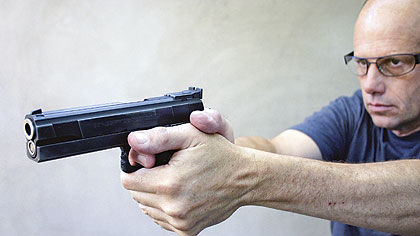 Brian Enos, along with his good friend Rob Leatham, developed the straight-thumbs method of gripping a handgun that is the standard among serious shooters today. Photo by Nidaa A. |
Ideally, what we want is a grip technique that causes the gun to point naturally at the target; we shouldn’t have to waste any time searching for and aligning the sights. Also, when the gun fires, we want it to track consistently, i.e. return to the exact same spot with no effort on our part. If we make that happen and learn how to reset the trigger action while the gun is still in recoil (an entirely different topic), we can fire the gun as fast as it comes down out of recoil and still be accurate.
No one knows more about fast and accurate handgunning than USPSA/IPSC Grand Masters. The United States Practical Shooting Association is the active body of the International Practical Shooting Confederation in the U.S., and Grand Master is its highest rating for shooting skill. These guys (I don’t want to sound sexist, but at this point there are no female GMs) are the gods of high-speed precision handgunning. Even among Grand Masters there are Grand Masters. Thus I enlisted the aid of two of the most famous and accomplished Grand Masters in USPSA history to get their advice on the topic of gripping the handgun for the maximum rate of accurate aimed fire.
Brian Enos, along with his good friend Rob Leatham, is credited with creating the straight-thumbs method of gripping a handgun so associated with the sport that many people call it the “IPSC grip.” Enos’ career as a sponsored shooter spanned two decades, with Smith & Wesson, European American Armory and Strayer-Voigt. He went 1-2 with Robbie Leatham at the 1983 Nationals; won the Bianchi Cup back-to-back in ’83-’84 and the Masters in ’89; and in the ’90s was a member of the winning three-man Sportsman’s Team Challenge team five times. He wrote Practical Shooting: Beyond Fundamentals, the most useful shooting manual in the history of IPSC. In 2000 he retired from professional shooting to start www.brianenos.com, a very successful Internet website and pro shop.
Dave Sevigny has burst onto the practical shooting scene like a supernova. Beyond any doubt the best Glock shooter on the planet, Dave began competing in IDPA and USPSA in 1999. Famous for using Glocks with very little or no modifications, Dave won his first IDPA state championship using his carry Glock 23 and inside-the-waistband holster. Since then he’s won more than 60 world, national, area and state IDPA/USPSA/IPSC championships. He’s the reigning USPSA National Production Champion, IDPA Stock Service Pistol National Champion, IPSC World Production Champion and Pan American Production Champion. He’s currently the anchor of Team Glock.
In this article I’m going to speak of “right hand” and “left hand” when discussing grip technique, going on the assumption that I’m talking to someone who master grips the gun with the right hand and uses his left hand as the support hand.
THUMB-OVER-THUMB
Let’s begin by talking about the thumb-over-thumb technique. At this time, no top shooter uses this grip; however, it still has its virtues, primarily that it’s a very easy technique to teach and very easy to execute. Even new shooters can understand this grip. This is usually, in my experience, not true of the straight-thumbs technique. When you try to teach straight-thumbs to newbies, it just doesn’t work. The necessary rolling forward of the wrist, so important to the “IPSC grip,” just feels totally weird to them. Their hands break apart under recoil. And you’d be absolutely amazed how many people there are in the world whose wrists simply won’t bend that far forward.
Brand-new shooters don’t need a technique that allows the Nth degree of speed and precision; they need a technique that’s easy to understand and execute, that will swiftly give them a decent level of performance.
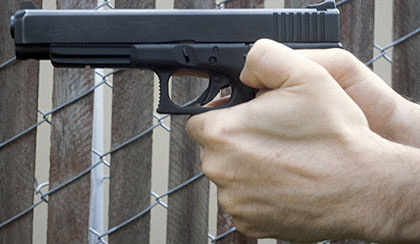 The thumb-over-thumb grip is not used by any top shooter; however, its easy “learnability” and execution by new shooters makes it an excellent first grip for beginners. |
Thumb-over-thumb is a universal technique that works with any type of gun–1911, SIG, Glock, revolver, anything. The same can’t be said of straight-thumbs. Shooters using straight-thumbs while firing SIGs find that, unless they specifically build their grip to move the right thumb slightly away from the side of the gun, they ride the slide stop with the shooting-hand thumb, and the slide won’t lock open when empty. With Glocks, shooters who use an especially high iteration of straight-thumbs sometimes find themselves pushing up on the slide stop with the heel of the support hand and locking the slide open with rounds still in the magazine. With a Browning Hi-Power, in my experience not only does the right-hand thumb depress the slide stop at its rear, but the left thumb bangs into the front of the slide stop in recoil, causing failures to feed and/or eject. The thumb-over-thumb grip gets the thumbs curled down and out of the way so they’re not banging off the controls.
Straight-thumbs can be an especially bad deal with revolvers. Dave Sevigny commented, “I grip the gun the exact same way whether I’m firing a Glock or a 1911, whatever; it doesn’t matter. The only time I’ll curl my thumbs down is when I’m firing a revolver. The first time you get a flash burn on your thumb firing a revolver straight-thumbs, you’ll never want to do it again.”
Thumb-over-thumb will reliably disengage the grip safety of a 1911 every time. Straight-thumbs, depending on the size and shape of the shooter’s hands, can pull the web of the master hand far enough away from the back of the piece
that the grip safety won’t be fully depressed, resulting in failures of the gun to fire.
There are two ways around this: You can pin the grip safety–not my preference–or you can have the grip safety “sensitized,” i.e. metal is taken off the underside of the grip-safety tongue (the protrusion off the front of the grip safety inside the gun that must rotate up and out of the way to allow the trigger bow to move far enough to the rear to trip the sear) so that, while still completely functional, the grip safety disengages with little inward movement. This is a modification easily performed by any competent pistolsmith or end-user.
The problem with thumb-over-thumb is that under stress it’s just all too easy, since you’re basically holding the gun wrapped in your fists, to begin muscling it, generating forces on the gun causing it to do a hula dance in recoil. Also, because wrapping the left thumb over the right opens up a gap between the heel and thumb of the left hand and the gun butt, the piece can twist in your hands under recoil, thus your group size explodes at speed. Straight-thumbs allows a much more neutral grip with better sight tracking and complete hand contact between the heel of the left hand and the side of the gun.
One very good thing about straight-thumbs is that it automatically rides the right thumb atop a 1911′s safety lever. Thus there’s no need to ingrain reflexive disengagement of the safety into part of the drawstroke, as there is with thumb-over-thumb, a procedure requiring thousands of repetitions before it becomes an unconscious reaction. Instead, with straight-thumbs it just happens when the hands meet, with no extra effort on the shooter’s part.
Given my experiences as a firearms instructor, I would say that newbies should almost invariably be taught thumb-over-thumb. Straight-thumbs is very much a technique for the serious, dedicated shooter in search of maximum performance.
 The most successful practical-pistol shooter in history (and still going strong after 25 years), Rob Leatham is one of the fathers of the straight-thumbs technique. |
STRAIGHT-THUMBS
The straight-thumbs method of gripping a handgun, which today has become the accepted wisdom among serious shooters, was developed in the early 1980s by Rob Leatham and Brian Enos. I’ve always wondered how that happened. Of all the possible ways you could grip a handgun, why did they come up with that one? This article provided me the opportunity to ask Brian Enos exactly that.
He responded, “Back in the late 1970s and early 1980s in IPSC competition, there were certain accepted ways to do things: the Weaver stance, for one. And the way we gripped the gun was what a lot of people call the Gunsite technique, where you’ve got your right thumb on top of the safety, and your left thumb comes up over that. Also back then, it was considered very smart to curl your left index finger around the front of the triggerguard. That’s what Kirk Kirkham taught me. When Robbie and I first started shooting, Kirk was the best. He’d just won the Nationals. He was, like, local hot dog made famous. I asked him, ‘How do you do this?’ He told me, ‘Finger around the triggerguard, Weaver, push/pull, this/that.’ I shot that way for a while.
“Back then, Robbie shot from what today we’d call a Chapman stance. He was just very natural, didn’t listen to anyone, didn’t ask anyone. I think our first big departure from tradition was [when], one day [when] we were practicing, Robbie just decided, ‘I’m going to stop shooting with my finger on the triggerguard. I’m just gonna do that.’ By the end of the day we were shooting at 50 yards; Robbie said he felt like he’d never shot that good at distance. He wasn’t that accurate of a shooter then. But he was doing really well and totally blaming it on his new grip: ‘My new grip has done this for me.’ So within a day or two I took my finger off the triggerguard, too.
“[When] the idea of pointing your thumbs straight at the target instead of curling one over the other came about, I was at the Steel Challenge. The first day, I had a horrible day, just one of those experiences when you feel like you’ve never held a gun before; the sights are kicking all over the place; it just feels totally foreign.
“That night in my hotel room, I started experimenting with changing my grip, just hour after hour of drawing into different grips. I’d noticed, when gripping the gun just with my fingers and palms, that that felt like a good, neutral grip, but when I added my thumbs, I felt like that extra pressure was causing the gun to track inconsistently. I wanted a technique that would take my thumbs out of my grip and off the sides of the gun so I was just gripping the gun with my palms and fingers.
“I started experimenting with my right-hand grip by only pulling front to rear with my fingers and just letting my right thumb rest on top of the thumb safety with no downward pressure. Then I noticed how resting my right thumb on top of the thumb safety opened up the entire side of the left grip panel, and I wondered, ‘What if I just put my left hand there?’ I rotated my wrist forward and pointed my thumb straight ahead, and that got my left thumb off the side of the gun. With the support hand I just squeezed left to right. So I wound up with front-to-rear pressure with the right hand and side-to-side pressure with the left hand, and that gave me very consistent, even pressure all the way around the gun.
“So I practiced that, drawing to it, drawing to it, for hours that night, just thinking, ‘This is the stupidest thing I’ve ever done; there’s no way this isn’t going to screw me up even worse.’ Well, I actually managed to pull it off the next day and shoot the match with that grip. The amazing thing was just how well the sights tracked that day. I’d never seen the sights track so consistently, especially in a match. They weren’t just flailing around out there; they were tracking up, then right back to the same spot. I’d never seen that in practice before; I’d never seen that sort of sight tracking, period. It felt so easy; the sights were lined up long before the gun got to each target.
 As this close-up of Brian Enos’ grip shows, in the straight-thumbs technique the support-hand thumb points straight ahead; the master-hand thumb is laid on top of the heel of the support hand and also points forward. The gun is a Strayer Voigt/Infinity .40. Photo by Nidaa A. |
“After that I started analyzing why this grip was working so well, and I realized it was because with that amount of even pressure on the gun, and the thumbs not pressing into the side of the gun with lateral pressure, your grip became almost like this mechanical device, a machine rest, that didn’t allow the gun to swivel left or right, just up and d
own. I got away from the idea of trying to use my grip to control recoil. I realized the amount of muzzle flip isn’t that important. What’s important is the consistency of how the gun moves, not how much it moves.”
HOW HARD TO GRIP THE GUN
Brian Enos: “I’ve found over the years that the stronger I grip the gun as long as I’m still able to manipulate the trigger precisely, the better I shoot. In my book I talk about ‘relaxing’ when I shoot, and that’s caused a lot of confusion. I wasn’t saying you shouldn’t grip the gun firmly; I was talking about my overall attitude while shooting. What you want is a really firm, fluid hold on the gun. When most people grip a gun ‘strongly,’ what they’re really saying is that they’re using their arms and shoulders to bear down on the gun, so it just beats them around every time they fire it.
“My arms aren’t a part of my grip. I learned to feel the grip as only in my hands. That realization was a real breakthrough for me, that the grip is its own thing, not part of your arm position. Set up your grip without being in position, then push your arms out in front of your face without doing anything else to it; that’s going to be a pretty good shooting position for you.”
Dave Sevigny: “Grip the gun as hard as it takes to track up and down with the least amount of muzzle rise. If your grip is too relaxed, the pistol will recoil too much, track erratically, or it may shut down (failure to feed/eject, etc.). Gripping too hard, by contrast, may negatively affect sight alignment, induce trigger freeze (failure to let the trigger return forward far enough between shots to reset) for multiple-shot engagements and create fatigue in your hands and forearms. The pistol type and caliber will dictate how much actual grip pressure is needed.”
SETTING THE WRIST
Brian Enos: “When I was experimenting in my hotel room that night at the Steel Challenge, I realized I wanted to get my hands as high up on the gun as possible. I found that camming my wrist over to get the heel of my left hand as high up and flat on the gun as possible allowed me to get my thumbs off the side of the gun.
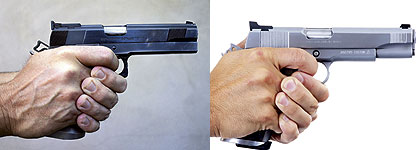 The master-hand index finger will ride up hard under the triggerguard, and the web of the master hand will be hard up under the tang with any good two-handed grip. Brian Enos (left), Dave Sevigny (above). Photo by Nidaa A. |
“Some people talk about ‘setting your wrist’ with the cammed-wrist technique to hold down recoil, and then there’s the 60/40 theory that you should squeeze harder with the left hand than the right hand. It’s never worked for me to think of it that way. The way I think of it is with both hands gripping the gun equally. When I can do that, I don’t feel like I have a left hand and a right hand; I have one hand, one hand on the gun. I will say that thinking about the two-hand grip like ’60/40′ does seem to help people not overgrip with the right hand. When you grip the gun too hard with your master hand, you lose the fine motor control in your index finger for precise trigger manipulation.”
Dave Sevigny: “For me, the support-hand wrist lock is a very important element to help reduce muzzle flip. Because the muzzle lifts during recoil, the top of the backstrap pushes rearward and the bottom of the frontstrap pushes forward. Controlling these two points is critical, and camming the wrist forward accomplishes that for me. Since it stops your hand from moving very much, it stops the gun from moving very much [as well].”
SIDE-TO-SIDE PRESSURE
Brian Enos: “Some people think the side-to-side pinching action of your left hand is there to make the gun track more consistently. Not really. The thing is, the gun wants to track consistently. The side-to-side pressure makes the gun track better only because it doesn’t make it worse. Your left hand does very little to decrease muzzle flip. All it’s going to do is allow the gun to return to where it was. That’s all a proper grip is; it allows you to hold the gun without adding any disturbance to the gun’s ability to do that. The purpose of your grip doesn’t cause the gun to track better; it’s that it doesn’t cause it to track worse. If you look at it with that approach, you’ll much more easily be able to develop techniques that don’t mess with the gun’s natural tendency to do that.”
Dave Sevigny: “It’s important to have the side-to-side pinching action of the support hand because, in order to have the best sight tracking, all parts of the grip should be in contact with your hands.”
THUMBS ON OR OFF?
Brian Enos considers not touching the side of the gun with the support-hand thumb a key element to consistent sight tracking, but not everyone agrees with that. Dave Sevigny does indeed touch the side of the gun with the support-hand thumb and considers that a significant part of his technique. He explained, “I think it’s very important not to overcompensate for anything; if you’re doing something on one side of the gun, you should do the same thing on the other side as much as possible. I put side-to-side pressure on the gun with my left hand and front-to-rear pressure with the right hand; I put the gun out there, muscling it just enough to keep it where I want it to be while I’m pulling the trigger. But you still have to pull the trigger with your right hand. I find that getting my thumb against the side of the gun balances everything out so you can resist trigger torque; you don’t wind up moving the gun off target when you pull the trigger. Placing the support-hand thumb along the frame seems to balance everything out for me, especially when pressing a four- to six-pound Glock trigger pull for every shot.”
HIGH ON THE GUN
Brian Enos: “It’s important to get high up on the gun. Your support-hand index finger should be hard up under the triggerguard with firm contact. Some people think that’s to stop you from pulling shots low–if you block the underside of the triggerguard, you can’t pull the gun down–but for me the only reason I get hard up under the triggerguard is just to get all of my hand higher up on the gun. It’s a physics thing; if you were going to hold the gun really low, like halfway down the grip, because the pivot point of the gun is so far from where you’re gripping it, the gun has more leverage to flip its muzzle in recoil. Most of the reason for the high position of the hands on the gun is improved leverage.
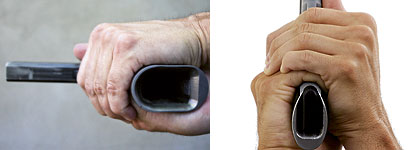 Shown from the bottom, the support-hand fingers completely encase the master-hand fingers. Brian Enos (below), Dave Sevigny (right). Photo by Nidaa A. |
“Let me make this clear: Within reason it doesn’t matter how high the front of the gun flips. What’s really important is the neutrality of the grip, that you don’t interfere with the gun’s inherent ability to return to the exact same spot
every time. The gun will do that on its own if you just let it. Getting your hands high up on the gun is to get more leverage to control muzzle flip; the neutral grip is another thing. The higher up you get on the gun, the less the muzzle will flip, and that’s a good thing, but it doesn’t affect the neutrality of the grip. I think it’s important not to mix those two concepts. You can have great sight tracking no matter how much the muzzle flips. With practice, your body learns to naturally return the gun to the same spot no matter how much it moves in between.”
Dave Sevigny: “Really, I want to get as high up on the gun as I can without interfering with the slide. The higher the better. If I could, I’d put my hand on top of the slide to hold it down. Getting as high up on the back of the gun as you can with your strong hand assists recoil management. To see for yourself, try a few rapid-fire shots with a half- to three-quarter-inch gap between the top of your strong hand and the grip tang. Then correct your grip, get your hand up under the tang with no gap, and shoot again. The results will speak for themselves.
“For me, contact under the triggerguard with the support-hand index finger strengthens the wrist lock and grip and serves as a locator during the draw. This ‘bridges’ the points between the triggerguard and the bottom of the frontstrap with your support hand while overlapping the strong hand. So when taking multiple shots and transitioning the gun (moving it from target to target), everything feels rock solid.”
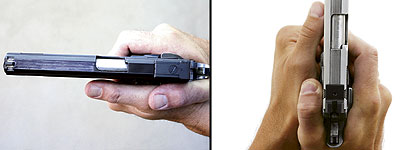 (Left) Brian Enos believes one of the keys to a successful grip is having no contact by the thumbs along the side of the gun. The grip should happen strictly in the palms and fingers. Photo by Nidaa A. (Right) Dave Sevigny does touch the side of the gun with his thumbs and also considers that an important part of his technique. |
SUMMARY
So as we’ve just seen, even among the very best shooters there’s room for differences of opinion on technique. Brian Enos’ viewpoint is that if you have a grip that doesn’t interfere with the gun, the piece will track consistently, up and down, right back to the same spot. Dave Sevigny is much more of a “hands on” shooter whose grip is built around the concept of making the gun do what he wants. There is no right or wrong here. As both men’s accomplishments show, either approach can work well. It’s just a matter of which works best for you.
While we don’t want to be mindless slaves to what has gone before as we develop our shooting technique, it’s also important not to waste immense amounts of time reinventing the wheel. The knowledge of how to grip a handgun for the absolute best combination of extreme accuracy and speed is out there. We have only to reach out and take it.